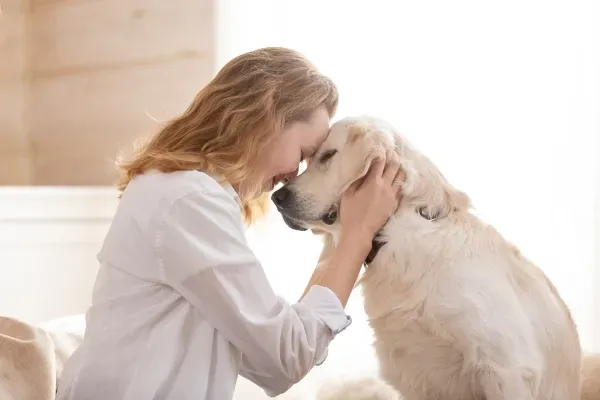
The Power of Touch: 3 Simple Massage Techniques to Calm Your Anxious Pet
The Power of Touch: 3 Simple Massage Techniques to Calm Your Anxious Pet
We've all been there—watching our beloved animal companion pace, pant, or hide during thunderstorms, when visitors arrive, or during other stressful situations. Their anxiety becomes our anxiety, creating a cycle that's difficult to break

We've all been there—watching our beloved animal companion pace, pant, or hide during thunderstorms, when visitors arrive, or during other stressful situations. Their anxiety becomes our anxiety, creating a cycle that's difficult to break.
What if you had a tool that could help calm your pet in minutes, using only your hands?
As both a licensed acupuncturist and a longtime animal companion, I've witnessed the remarkable power of touch to transform an animal's nervous system state. Today, I'm sharing three simple massage techniques that can help soothe your anxious pet and strengthen your bond in the process.
Why Touch Matters
Before diving into techniques, it's worth understanding why massage works so effectively for animals. Touch stimulates the parasympathetic nervous system—the "rest and digest" mode that counteracts the stress response. When performed mindfully, massage:
Lowers heart rate and blood pressure
Reduces stress hormones like cortisol
Releases endorphins and oxytocin (the "bonding hormone")
Creates a sense of safety and connection
Plus, animals are inherently tactile beings. Many species spend significant time in physical contact or grooming each other—activities that serve both social and calming functions.
Setting the Stage
Before beginning any massage, ensure:
Your animal is comfortable and receptive (never force touch)
Your own energy is calm (animals sense our state)
The environment is quiet and free from distractions
Your touch is gentle, especially when starting
Now, let's explore three techniques you can try today:
Technique 1: Long Stroking
This gentle, flowing technique is perfect for beginners and highly anxious animals.
How to perform:
Begin with your hand at your pet's head or neck
Slowly and smoothly stroke along the length of their back
Use very light pressure—just enough to move the fur
Continue down to the base of the tail
Repeat 10-15 times at a steady, slow pace
Best for: Initial calming, establishing comfort with touch, and creating a relaxation response. Effective for almost all species.
Technique 2: Circular Ear Massage
The ears contain numerous acupressure points connected to the entire body and are particularly effective for nervous system regulation.
How to perform:
Using your thumb and forefinger, gently hold the base of one ear
Apply the lightest pressure possible while making small circular motions
Gradually work from the base to the tip of the ear
Spend 1-2 minutes on each ear
Best for: Deepening relaxation, alleviating fear responses, and helping animals that are particularly stressed. Especially effective for dogs, cats, and rabbits.
Technique 3: Chest Calming
This technique targets an area many animals protect when stressed, so approach it gradually.
How to perform:
Once your pet is comfortable with other touches, place your palm gently on their chest
Rest your hand there without movement for 15-30 seconds
Begin making very slow, clockwise circles with light pressure
Continue for 1-2 minutes, keeping your movements rhythmic and predictable
Best for: Deep calming during or after anxiety episodes. Helps regulate breathing and heart rate. Works well for most mammals, especially dogs and horses.
Signs Your Massage Is Working
How will you know if your techniques are effective? Watch for:
Softening of the eyes
Deeper, slower breathing
Muscle relaxation (especially around the mouth and ears)
Sighing or yawning (signs of tension release)
Settled posture
If your animal moves away, respect their choice and try again later or with lighter touch.
Making It a Daily Practice
The true power of these techniques emerges when they become part of your daily routine. Even 3-5 minutes of mindful touch each day can significantly improve your animal's baseline nervous system regulation.
Consider integrating massage:
Before situations you know may cause anxiety
As part of an evening settling routine
During quiet moments of connection throughout the day
Remember that your own state directly influences your animal's ability to relax. Take a few deep breaths before beginning, and approach the practice as a meditation for both of you.
When to Seek Additional Support
While these techniques can help with mild to moderate anxiety, some animals may need additional support from a veterinarian, animal behaviorist, or other specialist. Consider professional guidance if your animal's anxiety:
Interferes with basic functions like eating or sleeping
Involves aggression or self-harm
Doesn't respond to consistent calming attempts
Appears suddenly in a previously calm animal
Touch is a powerful tool, but it works best as part of a holistic approach to your animal's wellbeing.
Your Journey Together
Learning to support your animal companion through touch is a journey—one that deepens your connection while building skills that serve you both. Start with just a few minutes today, observing closely and adjusting your approach based on your animal's responses.
I'd love to hear your experiences. Share your stories in the comments, or join our community for more support and techniques.
Remember, the most healing touch comes not from perfect technique, but from a place of presence, patience, and love.
Amalia Reeves is a licensed acupuncturist, massage therapist, and founder of PAWS to Heal Together. She brings over 20 years of experience in human bodywork to her practice with animals, creating accessible techniques for everyday caregivers.
